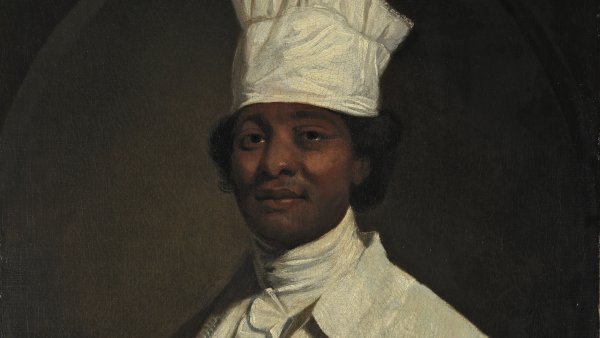Portrait of a Man from the Island of Dominica (?)
This bust portrait of an unknown man in white – long misattributed and misidentified – first came into public notice in England, where there is a precedent for this kind of likeness. Given its original location, it is possible that the sitter was the African servant or enslaved black attendant of a wealthy British citizen. In such a case, his outfit would bear witness to that citizen’s status. But while his striped silk coat could be seen as conventional household livery, the tall hat – in high-quality linen or silk, topped with lace – is quite extraordinary. Its design makes the identity of the sitter open to question. In fact, the representation of this stunning crown has played (and must play) an operative role in the interpretation of the picture.
The portrait can be dated by the man’s neckpiece and the cut of his coat, as well as the painting style, to about 1780. As a whole – including the canvas size and painted oval – the picture is convincingly English, but the sitter need not be. There are alternatives: he could be a foreign visitor from Africa or its diaspora, and this could explain the odd hat design.
Contrary to what might be expected, the closest approximation to this hat is not found on an African aristocrat or an African Muslim of the period. Instead, its twin – though not identical – is found sitting on the head of a free West Indian on the island of Dominica, as depicted by Agostino Brunias in about 1770. If the Thyssen sitter is Dominican, he probably fled to England as part of the exodus of English planters just before the French claimed the island from the English in 1778.
With the face and hat rendered in relatively broad brushstrokes, the portrait follows the general painting style of Sir Joshua Reynolds, the first president of the Royal Academy in London (1768–92). The artist of this likeness was clearly talented and apparently intrigued by the challenge of convincingly rendering flickers of light on the coat’s slightly ribbed, cream-coloured surface. The dark colouring of the sitter’s skin and hair in shades of brown, rust and black provides a marked contrast to the nuanced differences in the sheen of the off-white clothing.
The prominent hat in the Thyssen portrait inevitably played a role in an accretion of erroneous interpretations. Superficially it resembles a standard chef’s toque, but that archetypal hat did not come into being until the 1820s, too late for this sitter but perfect for complicating interpretations of the portrait. The chef’s identification not only stuck but also got to be elaborated over time. For about forty years in the 20th century, the Thyssen portrait was misidentified and published as Gilbert Stuart’s portrait of George Washington’s cook. It is neither by Stuart – who is famous for having painted admired portraits of the first president of the United States – nor of Washington’s cook. Such a person never wore a hat like this. Wrongly understood, the picture appeals to ameliorating fantasies about American slavery and helps fulfil a desire in the United States to find overlooked African-Americans of historical importance.
The artist, the sitter or the meaning of the costume might be determined in the future, especially if historical mention can be found. As it is, the picture assumes value as a well-painted, arresting portrait. In all likelihood, with so much missing, it will always remain completely or partly a mystery.
Dorinda Evans






